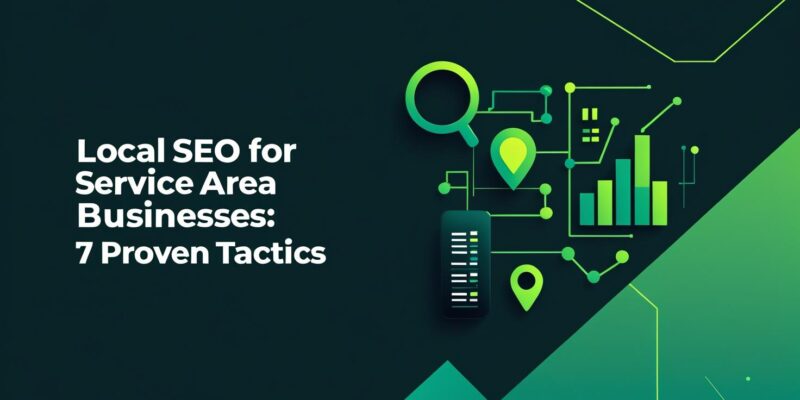I’ve worked with a lot of service area businesses (SABs) plumbers, roofers, home renovators, pest control guys, HVAC companies, movers, you name it.
And one thing is always the same
They want more calls and more leads, but their online setup is broken.
They either rely on word of mouth, or they hire an SEO who just builds a few backlinks and prays. The result? Months later, no rankings, no calls… and frustration.
That’s exactly why local SEO for service area businesses exists. If you’re a contractor, cleaner, or any type of service provider, this isn’t optional anymore. It’s the difference between being visible in Google Maps… or being invisible when people are searching for you right now.
In this post, I’ll share seven proven tactics that I use for clients, plus the common mistakes that keep most service providers from ranking.
If you want to know how to rank a service area business, keep reading, because this is the real-world playbook.
1. Nail Your Google Business Profile (GBP)
Your GBP is your storefront on Google. Without it, you can’t compete. Period.
But here’s what I see most often:
- The business sets it up once, never touches it again.
- No proper service areas defined.
- Photos? Zero. Posts? Dead.
That’s not enough.
What you should do instead:
- Add all your service areas (not just a single office address)
- Keep your NAP (Name, Address, Phone) 100% consistent everywhere online
- Select the right primary + secondary categories
- Upload before-and-after job photos, not just stock images
- Post weekly updates (offers, seasonal tips, project highlights)
I had a client, a home renovation company that wasn’t even showing up for “kitchen remodelers near me.” We simply optimized their GBP properly and within 3 months, they started pulling in 30+ calls per month just from Maps.
That’s the power of doing SEO for service providers at the foundation level.
2. Target Local Keywords the Smart Way
If you’re trying to rank for just “plumber” or “roofer,” good luck competing with Yelp, HomeAdvisor, and the big brands.
The money is in local intent keywords. For example:
- “Emergency plumber in Dallas”
- “Roof leak repair Austin TX”
- “Best pest control near me”
Google knows when the user’s intent is local, that’s when your service area setup and keyword targeting matter.
Pro tip:
If you serve multiple areas, don’t try to cram all the city names onto one page. Create separate location pages, each optimized for one area.
For example, instead of one generic “Service Areas” page, build:
- /plumber-dallas
- /plumber-fort-worth
- /plumber-arlington
Each page should have unique content, testimonials from customers in that city, and localized keywords. That’s how you actually show Google you’re relevant.
This is one of the most underrated parts of local SEO for service area businesses.
3. Collect (and Respond to) Reviews
I’ve never seen a SAB rank long-term without reviews.
And not just one or two. I’m talking about dozens, ideally hundreds of reviews.
Here’s the truth:
- A competitor with 200 solid reviews will outrank you if you’re stuck at 10.
- Google also looks at how frequently you get new reviews, not just the total.
- And yes, responding to reviews matters.
What you should do:
- Send customers a review link immediately after the job. (Don’t wait, they’ll forget.)
- Make it easy, text or email with one click.
- Thank happy customers in your responses.
- Stay professional if you get a negative review.
I worked with a moving company that was stuck at 14 reviews for 2 years. We built a system where their staff politely asked every client to leave a review right after the move. Within 6 months, they had 120 reviews. Their Maps ranking shot up, and calls increased by 70%.
This is why reviews are a non-negotiable part of SEO for service providers.
4. Build Localized Content That Actually Works
Most service area websites are painfully generic. Same 200 words on every service page. That doesn’t rank anymore.
What works is localized content:
- Service pages customized for each area
- Blog posts tied to local issues/events (“Best Time for Roof Repairs in Chicago”)
- Case studies with before-and-after photos of real jobs in the area
- Testimonials from customers in that exact city
For example, if you’re a roofing company serving multiple cities, don’t just say “we fix roofs everywhere.” Create unique pages:
- “Roof Repair in Austin: What Homeowners Should Know”
- “How to Handle Hail Damage in Dallas Roofs”
This tells Google: you’re not just any roofer, you’re a roofer relevant to that city’s problems.
That’s why local SEO for service-area businesses always involves strong, city-specific content.
5. Optimize Your Website for Local Searches
Even if your GBP is strong, if your website is weak, you’ll still struggle.
Here’s what you need to fix:
- Mobile-first design (most local searches are on phones)
- Fast loading (nobody waits more than 3 seconds)
- Local Business Schema markup (helps Google understand your business)
- Clear CTAs: clickable phone number, contact forms, easy navigation
- Address and service areas clearly visible
A quick story: I worked with a pest control company whose site looked like it was built in 2005. Slow, clunky, and with no schema markup. We rebuilt it into a modern, fast, mobile-friendly site, added Local Business Schema, and within weeks, their impressions in Google doubled.
This is where google local seo for service area businesses kicks in. Structured data + optimized site = Google finally understands who you are and what you do.
6. Build Local Backlinks and Citations
Links still matter. But for SABs, local links matter more than high DA generic links.
Examples of good local backlinks:
- Sponsor a local school team (they’ll link to you on their website)
- Get featured in local newspapers or blogs
- Partner with nearby businesses and exchange mentions
- Submit to local business directories (but only high-quality ones)
Think of backlinks as online recommendations. The more local sites vouch for you, the more Google trusts you’re a real business.
Citations (like Yelp, Angie’s List, Thumbtack, Houzz, etc.) are also important. But the key is consistency. Your name, address, and phone number must match across all platforms.
This is a common reason businesses fail at local SEO for service area business, inconsistent citations.
7. Use Social Media for Local Visibility
Social media won’t directly boost your rankings — but it will increase your visibility, which indirectly helps.
What you should do:
- Post before-and-after photos of jobs (people love transformations)
- Share customer stories and testimonials
- Highlight seasonal offers or discounts
- Run small geo-targeted ads to boost visibility in your city
Example: A fence contractor I worked with started posting 30-second TikToks of his projects. Nothing fancy, just before/after clips. One video hit 20k views locally, and he got 5 new contracts in a week.
That’s the kind of boost social media gives to local businesses.
Common Mistakes That Kill Rankings
Let me also highlight what not to do, because I see this all the time:
- Inconsistent NAP across directories
- Ignoring reviews (or worse, faking them)
- Using duplicate content across city pages
- Over-optimizing with keywords (Google sees through it)
- Not tracking leads (so you can’t even prove SEO is working)
These mistakes quietly kill rankings.
Lastly,
So if you’re wondering how to rank a service area business, the answer isn’t complicated. But it does require consistency.
Do the basics right:
- A fully optimized Google Business Profile
- Strong service + location pages
- Consistent flow of real reviews
- Fast, mobile-friendly website with schema
- Local backlinks and citations
- Active social presence
Most competitors will only do 20% of this. If you commit to all 7, you’ll outrank them.
That’s the power of local SEO for service area businesses when done properly.
And here’s the good news: unlike eCommerce or SaaS, service area businesses don’t need hundreds of backlinks or massive budgets. They just need to get the fundamentals right.
If you do, you won’t just rank higher, you’ll get more calls, more customers, and steady growth for years.
Written by Fuzail Anwar
SEO Expert | Helping businesses worldwide
If you need help Lets Connect




